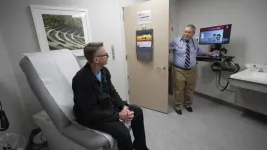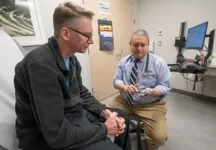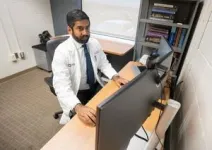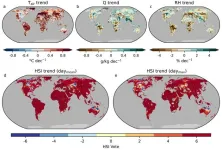(Press-News.org) COLUMBUS, Ohio – Artificial intelligence (AI) is all around us – from smart home devices to entertainment and social media algorithms. But is AI okay in healthcare? A new national survey commissioned by The Ohio State University Wexner Medical Center finds most Americans believe it is, with a few reservations.
The national poll of 1,006 people found:
75% believe using AI to minimize human errors is important.
71% would like AI to reduce wait times.
70% are comfortable with AI taking notes during an appointment.
66% believe AI should improve work-life balance for health care providers.
To address some of these issues, The Ohio State Wexner Medical Center is piloting the Microsoft Dragon Ambient eXperience (DAX) Copilot application. It uses conversational, ambient and generative AI to securely listen to a provider-patient visit and draft clinical notes in the patient’s electronic medical record. Rather than the provider typing the notes during the visit, they can focus on the patient then review and edit the notes afterward.
Ravi Tripathi, MD, chief health information officer at the Ohio State Wexner Medical Center, led the pilot program. From mid-January to mid-March this year, 24 physicians and advanced practice providers in primary care, cardiology and obstetrics and gynecology tested the technology during outpatient clinic visits. After obtaining the patient’s permission, the provider records the visit through the AI application. Once the visit is complete, the notes are organized and ready for review in less than a minute.
“We found it saved up to four minutes per visit. That’s time the physician can use to connect with the patient, do education and make sure they understand the plan going forward,” Tripathi said. “A few clinicians preferred their old workflow but, overall, 80% completed the pilot. In fact, we allowed them to keep using the AI solution afterward because it had significantly impacted their practices in the eight weeks of testing.”
One of the pilot participants was Harrison Jackson, MD, an internist who has been frustrated by the typing that has to take place during each patient visit.
“Documentation is necessary, but it takes away from the quality of patient interaction during a visit. I even apologize. I say, ‘I’m sorry, I know I'm making more eye contact with the computer than with you,’” Jackson said.
After testing AI documentation, Jackson reports some occasional missteps such as incorrect pronouns or mistaking one word for another – all things he said were easily fixed during his chart review. He supports the use of AI going forward in healthcare.
“I’m spending as much if not more time with each patient, and it’s higher quality time with more eye contact. I often mention aspects of a physical exam out loud for the AI program to capture, and it prompts a good conversation with my patient,” Jackson said. “I’ve also let our residents use the technology under my supervision, and we’ve noticed the quality of their patient interactions and the quality of plans they present have improved.”
While most Americans also see value in AI for healthcare, the survey found just over half (56%) still find it a little scary and 70% have concerns about data privacy.
“I know patients are concerned about the privacy and the security of their data, but we hold the artificial intelligence and this technology to the same standards that we hold our electronic medical record,” Tripathi said.
As of July 1, Ohio State expanded ambient documentation access to all providers in outpatient settings. In the first two weeks of expanded use, 100 clinicians regained 64 hours of time and satisfaction scores have improved from patients who say their conversations with their physicians were more valuable.
Survey Methodology
This study was conducted on behalf of The Ohio State University Comprehensive Cancer Center by SSRS on its Opinion Panel Omnibus platform. The SSRS Opinion Panel Omnibus is a national, twice-per-month, probability-based survey. Data collection was conducted from May 17 – 20, 2024, among a sample of 1,006 respondents. The survey was conducted via web (n=974) and telephone (n=32) and administered in English. The margin of error for total respondents is +/- 3.5 percentage points at the 95% confidence level. All SSRS Opinion Panel Omnibus data are weighted to represent the target population of U.S. adults ages 18 or older.
###
END
Long-term exposure to arsenic, a hidden danger in many New England drinking water supplies, poses serious health risks, including cancer and cognitive challenges. A groundbreaking citizen science initiative called "All About Arsenic" has emerged in response, empowering students and communities to tackle such health threats head-on.
The benefits are detailed in a peer-reviewed article published today in the journal Environmental Health Perspectives. An accompanying commentary by researchers at Columbia University’s Mailman School of Public ...
Osaka, Japan – From the high-voltage wires that carry electricity over long distances, to the tungsten filaments in our incandescent lights, we may have become accustomed to thinking that electrical conductors are always made of metal. But for decades, scientists have been working on advanced materials based on carbon-based oligomer chains that can also conduct electricity. These include the organic light-emitting devices found in some modern smartphones and computers.
In quantum mechanics, electrons are not just point particles with definite ...
Watching your children frolic through a playground is one of the many joys of being a parent or grandparent, but new research has found that engaging in play with kids could help improve mental health.
Researchers from the University of South Australia (UniSA) and the University of Canberra (UC) have explored the benefits of intergenerational play through specially designed playgrounds for kids and adults.
Intergenerational play brings young children and older people together to engage in enjoyable and creative activities such as storytelling, using playground equipment, and games.
The world is facing an ...
Governments, medical institutions and other bodies require accurate models on health-related matters in order to better organize their activities. Climate change has measurable impacts on society, including on human mortality. However, current models to assess the health impacts of climate change do not account for every environmental parameter, especially humidity, which could influence heat stress perceived by the human body, leaving room for improvement. For the first time, researchers, including those from the University of Tokyo, successfully incorporated humidity data from hundreds of cities into so-called heat stress indicators ...
In brief
Extreme weather is leading to more frequent power grid strain and electricity outages.
There are a range of regional cooperation agreements among utilities to share electricity.
Expanding cooperation areas in the West could cut outage risks by as much as 40%.
Expanding cooperation among electricity providers could also help ensure public opinion and policy remain favorable for renewable energy growth.
This summer’s Western heat waves raise the specter of recent years’ rotating power outages and record-breaking electricity demand in the region. ...
How do bad bacteria find entry points in the body to cause infection?
This question is fundamental for infectious disease experts and people who study bacteria. Harmful pathogens, like Salmonella, find their way through a complex gut system where they are vastly outnumbered by good microbes and immune cells. Still, the pathogens navigate to find vulnerable entry points in the gut that would allow them to invade and infect the body.
A team of UC Davis Health researchers has discovered a novel bioelectrical mechanism these pathogens use to find these openings. Their study was ...
Today, Rensselaer Polytechnic Institute and Hokkaido University of Japan announced their plan to explore collaborative opportunities in semiconductor education and research contributing to semiconductor workforce development initiatives.
The two universities recognized the new partnership with a letter of intent signing ceremony held in the Curtis R. Priem Experimental Media and Performing Arts Center, with representatives from the Hokkaido Prefecture government, the Japanese semiconductor company Rapidus, IBM, NY CREATES, and RPI faculty and students in attendance.
Before the signing ceremony, the Japanese delegation toured the IBM Quantum System One ...
Even light smoking of just 1-2 cigarettes a day either before or at any time during pregnancy is significantly associated with major health problems in the newborn, finds research published online in the Journal of Epidemiology & Community Health.
The findings add to the evidence indicating that women hoping to become, or who are, pregnant should stub out smoking to protect their newborn’s health, say the researchers.
Deaths and serious health issues among newborns have fallen sharply, largely due to improvements in maternity care. But admission ...
Social position—defined by household income and job role—is linked to food delivery preferences in England, suggests an analysis of consumer research published in the open access journal BMJ Public Health.
Affluent households are twice as likely as less well off ones to shop online for groceries while households in lower social grades are up to twice as likely to use food delivery apps for take-away meals. And users of these apps are more likely to be living with obesity, the findings indicate.
Digital on-demand ...
Twenty minutes of mindful breathing, which focuses a person’s attention on their breath, can rapidly reduce the intensity and unpleasantness of cancer pain and relieve the associated anxiety, suggest the findings of a small comparative study, published online in the journal BMJ Supportive & Palliative Care.
Mindful breathing complements traditional pain relief and broadens the repertoire of options available for cancer patients, say the researchers.
Moderate to severe pain affects an estimated 30-40% of patients with cancer worldwide, as a result of the tumour compressing or ...






